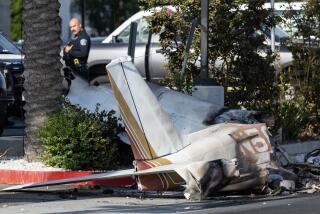Faulty carburetor likely led to Harrison Fordâs plane crash, NTSB says
Harrison Fordâs vintage plane likely crashed because of a carburetor problem that caused the engine to lose power after taking off from Santa Monica Airport, according to a National Transportation Safety Board report released Thursday.
The problem part was found separated from its mounts, and the threads holding the crucial piece of the part together appeared to be rounded off.
The NTSB report said the carburetorâs main metering jet controls the planeâs fuel flow, providing âa constant mixture ratio over the cruising range of engine operating speeds.â The piece is found between the discharge nozzle and the float chamber.
The carburetor was last checked in 1998, when the plane underwent extensive restoration and an engine overhaul. But carburetor manuals didnât offer âpertinent instructions regarding installations or continued maintenance of the jet assemblies,â the report stated.
Ford told federal investigators his plane lost power March 5 after taking off from the airport and crashed as he was trying to get back to the facility.
Ford was seriously hurt when the plane came down in a golf course, but no one on the ground was injured.
Ford told investigators he did not remember the actual crash but relayed what happened moments before.
âThe pilot reported ... the engine experienced a loss of power. He stated that he did not attempt an engine restart but maintained an airspeed of 85 mph and initiated a left turn back toward the airport; however, during the approach, he realized that the airplane was unable to reach the runway,â the report said.
âSubsequently, the airplane struck the top of a tree that was about 65 ft tall, and then impacted the ground in an open area of a golf course,â according to the report.
The new study confirms many details in a preliminary report by the NTSB published in March.
Best known for his roles in the âStar Warsâ and the Indiana Jones movies, Ford crash-landed in a clearing on the course, about 800 feet southwest of the airport runway.
According to the NTSB report, Ford advised Santa Monica air traffic controllers of an engine failure soon after takeoff and requested an immediate return to the airport.
Investigators said he then initiated a left turn back toward the runway and struck the top of a tall tree before he came down in an open area of Penmar Golf Course. The NTSB said that the wings and fuselage of the plane were substantially damaged.
The small yellow-and-silver monoplane was built in 1942 and is registered to MG Aviation Inc. in Delaware. That type of aircraft served as a primary trainer for the U.S. Army Air Forces during World War II.
Twitter: @VeronicaRochaLA and @LADeadline16
MORE ON HARRISON FORD PLANE CRASH:
Harrison Fordâs plane crash could spur efforts to close Santa Monica Airport
After plane crash, Harrison Ford to narrate aviation documentary
Preliminary probe of Harrison Ford plane crash confirms engine failure
More to Read
Sign up for Essential California
The most important California stories and recommendations in your inbox every morning.
You may occasionally receive promotional content from the Los Angeles Times.










